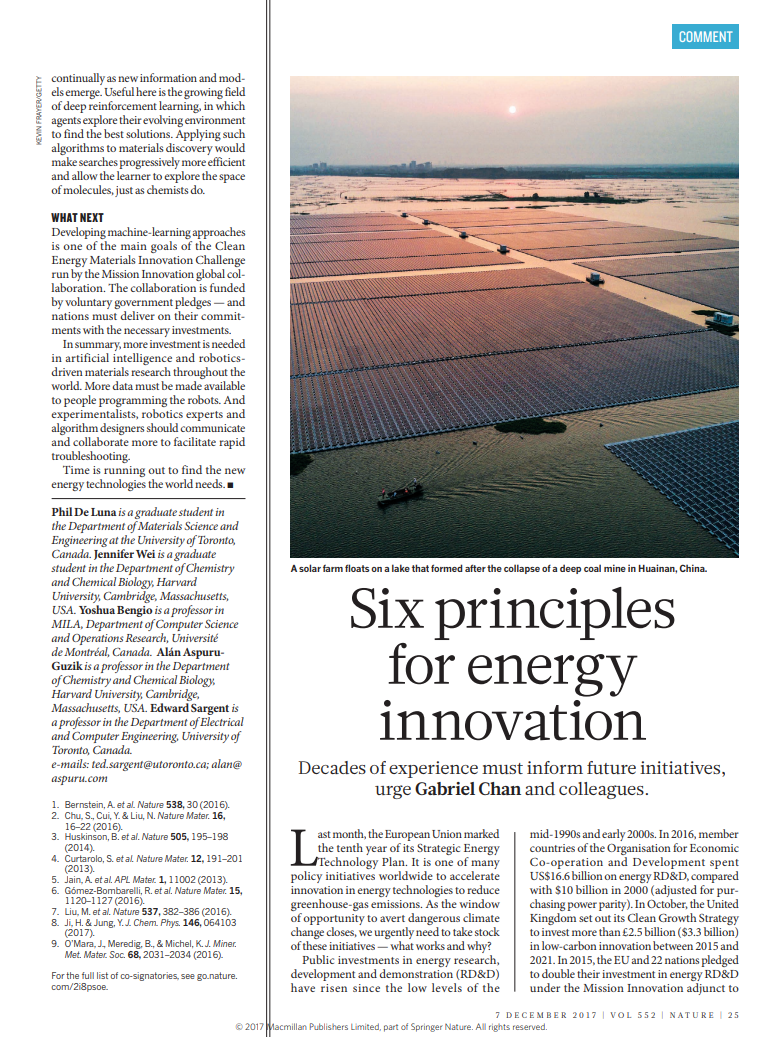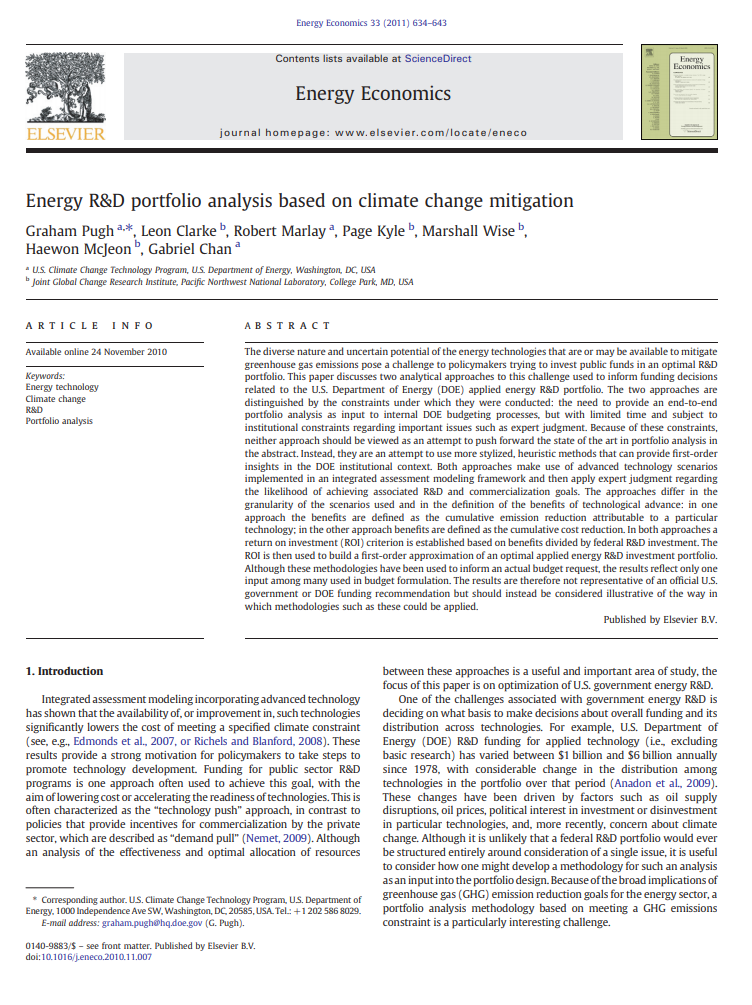Innovation Systems
While innovation is widely seen an essential tool to meeting the global challenge of sustainable development, our understanding of how innovation systems work and can be strengthened remains poorly understood. Our work in this area seeks to better characterize the dynamics of innovation systems, such as the role of "innovation spillovers," breakthroughs carried from one sector to advance progress in another. We're studying how innovation in key energy technologies (PV, batteries, and LEDs) were spurred by spillovers in other domains.
journal article
Six Principles for Energy Innovation
Researchers propose six guiding principles to make policy initiatives for energy innovation work:
Give researchers and technical experts autonomy and influence over funding decisions.
Incorporate technology transfer in research organizations.
Focus demonstration projects on learning.
Incentivize international collaboration.
Adopt an adaptive learning strategy.
Keep funding stable and predictable.
Chan, Gabriel, Anna P. Goldstein, Amitai Bin-nun, Laura Diaz Anadon, and Venkatesh Narayanamurti. "Six principles for energy innovation." Nature 552, no. 7683 (2017): 25-27.
PODCAST
PUBLIC FUNDING FOR ENERGY RESEARCH AND DEVELOPMENT
Effective decision making to allocate public funds for energy technology research, development, and demonstration (R&D) requires considering alternative investment opportunities that can have large but highly uncertain returns and a multitude of positive or negative interactions. In this podcast, Gabriel Chan, explores the utility of applying new methods to improve the cost-effectiveness and environmental performance in a deliberative approach to energy R&D portfolio decision making.
journal article
The Pressing Energy Innovation Challenge of the US National Labs
Accelerating the development and deployment of energy technologies is a pressing challenge. Doing so will require policy reform that improves the efficacy of public research organizations and strengthens the links between public and private innovators. With their US$14 billion annual budget and unique mandates, the US National Laboratories have the potential to critically advance energy innovation, yet reviews of their performance find several areas of weak organizational design. Here, we discuss the challenges the National Laboratories face in engaging the private sector, increasing their contributions to transformative research, and developing culture and management practices to better support innovation. We also offer recommendations for how policymakers can address these challenges.
Anadon, Laura Diaz, Gabriel Chan, Amitai Y. Bin-Nun, and Venkatesh Narayanamurti (2016). The pressing energy innovation challenge of the US National Laboratories. Nature Energy, Article Number 16117.
journal article
Making Technological Innovation Work for Sustainable Development
This paper presents insights and action proposals to better harness technological innovation for sustainable development. We begin with three key insights from scholarship and practice. First, technological innovation processes do not follow a set sequence but rather emerge from complex adaptive systems involving many actors and institutions operating simultaneously from local to global scales. Barriers arise at all stages of innovation, from the invention of a technology through its selection, production, adaptation, adoption, and retirement. Second, learning from past efforts to mobilize innovation for sustainable development can be greatly improved through structured cross-sectoral comparisons that recognize the socio-technical nature of innovation systems. Third, current institutions (rules, norms, and incentives) shaping technological innovation are often not aligned toward the goals of sustainable development because impoverished, marginalized, and unborn populations too often lack the economic and political power to shape innovation systems to meet their needs. However, these institutions can be reformed, and many actors have the power to do so through research, advocacy, training, convening, policymaking, and financing. We conclude with three practice-oriented recommendations to further realize the potential of innovation for sustainable development: (i) channels for regularized learning across domains of practice should be established; (ii) measures that systematically take into account the interests of underserved populations throughout the innovation process should be developed; and (iii) institutions should be reformed to reorient innovation systems toward sustainable development and ensure that all innovation stages and scales are considered at the outset.
Anadon, Laura Diaz, Gabriel Chan, Alicia G. Harley, Kira Matus, Suerie Moon, Sharmila L. Murthy, and William C. Clark (2016). “Making technological innovation work for sustainable development.” Proceedings of the National Academy of Sciences 113(35): 9682-9690.
ISSUE BRIEF
COOPERATIVE CLIMATE CHANGE R&D THAT WORKS
International cooperation provides the opportunity to accelerate innovation while also broadening access to and deployment of new inventions. However, these efforts also face multiple roadblocks in implementation. Here we propose a set of five key principles to establish cooperative R&D arrangements. We believe following these principles will lead to the formation of cooperative R&D arrangements which will enjoy the advantages of collaboration while bypassing many of the potential barriers.
OP-ED
HOW TO FIX THE NATIONAL LABORATORIES
Writing in the National Interest, Laura Diaz Anadon, Gabriel Chan, Amitai Bin-Nun, and Venkatesh Narayanamurti lay out a set of recommendations to reform the Department of Energy’s National Labs.
TESTIMONTY
SECURING AMERICA’S FUTURE: REALIZING THE POTENTIAL OF THE DOE NATIONAL LABORATORIES
Written Testimony to the U.S. Senate Appropriations Subcommittee on Energy & Water Development, delivered by Venkatesh Narayanamurti with Laura Diaz Anadon, Gabriel Chan, and Amitai Bin-Nun.
journal article
Energy R&D Portfolio Analysis Based on Climate Change Mitigation
The diverse nature and uncertain potential of the energy technologies that are or may be available to mitigate greenhouse gas emissions pose a challenge to policymakers trying to invest public funds in an optimal R&D portfolio. This paper discusses two analytical approaches to this challenge used to inform funding decisions related to the U.S. Department of Energy (DOE) applied energy R&D portfolio. The two approaches are distinguished by the constraints under which they were conducted: the need to provide an end-to-end portfolio analysis as input to internal DOE budgeting processes, but with limited time and subject to institutional constraints regarding important issues such as expert judgment. Because of these constraints, neither approach should be viewed as an attempt to push forward the state of the art in portfolio analysis in the abstract. Instead, they are an attempt to use more stylized, heuristic methods that can provide first-order insights in the DOE institutional context. Both approaches make use of advanced technology scenarios implemented in an integrated assessment modeling framework and then apply expert judgment regarding the likelihood of achieving associated R&D and commercialization goals. The approaches differ in the granularity of the scenarios used and in the definition of the benefits of technological advance: in one approach the benefits are defined as the cumulative emission reduction attributable to a particular technology; in the other approach benefits are defined as the cumulative cost reduction. In both approaches a return on investment (ROI) criterion is established based on benefits divided by federal R&D investment. The ROI is then used to build a first-order approximation of an optimal applied energy R&D investment portfolio. Although these methodologies have been used to inform an actual budget request, the results reflect only one input among many used in budget formulation. The results are therefore not representative of an official U.S. government or DOE funding recommendation but should instead be considered illustrative of the way in which methodologies such as these could be applied.
Pugh, Graham, Leon Clarke, Robert Marlay, Page Kyle, Marshall Wise, Haewon McJeon, and Gabriel Chan (2011). “Energy R&D Portfolio Analysis Based on Climate Change Mitigation.” Energy Economics 33(4): 634-643.







